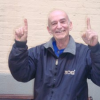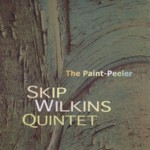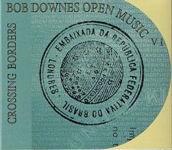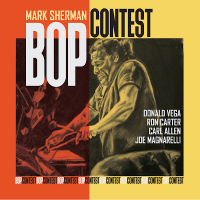Home » Jazz Articles » Profile » Cleve Pozar: The Web of Percussion
Cleve Pozar: The Web of Percussion
 It has become somewhat commonplace in the past few years for improvising musicians who made names for themselves in the New York underground (and who have since dropped out of the scene) to make something of a comeback. These comebacks are welcome to those of us who didn't get a chance to see their work in the flesh during the loft-jazz heyday—bassist Henry Grimes is the most celebrated example, having disappeared without a trace until the last decade. But to make a return visit via the 21st century phenomenon of the World Wide Web and social bookmarking isn't usually the chosen method of jazzmen. Percussionist and instrument-maker Cleve Pozar is the exception to that rule, having broadcast videos of his homemade electro-acoustic bata on YouTube since 2007 and completely circumventing the jazz/free music audience in the process.
It has become somewhat commonplace in the past few years for improvising musicians who made names for themselves in the New York underground (and who have since dropped out of the scene) to make something of a comeback. These comebacks are welcome to those of us who didn't get a chance to see their work in the flesh during the loft-jazz heyday—bassist Henry Grimes is the most celebrated example, having disappeared without a trace until the last decade. But to make a return visit via the 21st century phenomenon of the World Wide Web and social bookmarking isn't usually the chosen method of jazzmen. Percussionist and instrument-maker Cleve Pozar is the exception to that rule, having broadcast videos of his homemade electro-acoustic bata on YouTube since 2007 and completely circumventing the jazz/free music audience in the process.Pozar was born Robert Frank Pozar in Eveleth, Minnesota in 1941, and became serious about playing the drums in high school. "One night I was listening to the radio to the Miles Davis quintet and Philly Joe was smoking—and I heard the music Philly was making and I said 'I don't know what that guy's doing but I want to do that for the rest of my life.' My grades in high school went down and my Philly Joe playing went up! My big influence was Philly Joe then, and it still is. I also listened to Elvin and Tony Williams, but of course I never recorded anything like that." After high school, Pozar attended the University of Michigan at Ann Arbor, and soon fell in with composers and artists associated with experimental music, mostly through his teacher, James Salmon. "After my first semester I started playing the ONCE Festival, so I based all my later playing more on that style of percussion than anything else." The ONCE Festival was held at the University of Michigan from 1961-1966 and featured the music of composers like Robert Ashley, Gordon Mumma, and David Behrman (all of whom attended the university and who later became known in the field of contemporary electronic composition) as well as Pauline Oliveros, Roger Reynolds, and others.
Early on, Pozar met pianist Bob James, and their playing together was admittedly quite heavily influenced by working with Mumma and Ashley and the other ONCE participants. "Bob and I were working with these composers, and there was a place that we played in Ann Arbor, this artist's loft where we would go and improvise as a duo, and they would be working with the tapes and stuff. Not only that, we were in a lot of the ensembles together in the ONCE Festival. So that was a direct influence on some of what we did on that trio record, Bold Conceptions." The album featured their trio with bassist Ron Brooks and was the result of the group's winning the Collegiate Jazz Festival at Notre Dame University in 1962. Despite the presence of standards and tunes from the books of Miles Davis and Dizzy Gillespie, the music itself tugs at piano-trio convention in a constant rhythmic push-pull, with coloristic elements that utilize the inside of the piano as well as magnetic tape. These explorations would be expanded on a freer date for ESP, Explosions, recorded in New York with bassist Barre Phillips as well as contributions from Ashley and Mumma. But as Pozar puts it, "I moved to New York to study mallet percussion, and I had no incentive whatsoever to play in New York. I only wanted to study."
Through meeting and playing with reedman Ed Curran, Pozar soon became a regular fixture in trumpeter-composer Bill Dixon's ensembles. "I was not only playing in Bill's band, but I was also studying with him. At one point I hadn't taken a lesson in a couple of weeks. We were working with Judy Dunn and her dance company. Judy looked at me one day and said 'how come you aren't taking your lessons with Bill?' I told her I was broke and I could hardly buy food. The lessons were at my house; he'd come by with two quarts of Ballantine ale for us. So a day after telling Judy my story there is a knock on my door. Bill walks in with two bags—one is filled with food and the other is filled with Ballantine. He goes to the fridge and puts in the food then opens up two Ballantines, hands one to me and says 'now play the lesson.' I did and he said 'don't ever do that to me again.' I never forgot that." Pozar recorded with Dixon on the trumpeter's watershed 1967 RCA-Victor date Intents and Purposes: The Bill Dixon Orchestra and also recorded as a leader for Savoy, Good Golly Miss Nancy, through Dixon's production and tutelage.
Pozar moved out of New York in the late Sixties, which resulted from expanding upon his percussion studies with Alan Dawson at Berklee School of Music in Boston. "I have two mentors in my life; one is Mr. Salmon from the University of Michigan and the other is Alan Dawson." He woodshedded in a cabin in a stone quarry in New Hampshire during this time, working as a plumber and commuting to Berklee. Eventually he scuttled his commuter lifestyle and settled in the city; the recorded result of this period is a scarce self-released audio-collage LP, Cleve Solo Percussion (he changed his name legally to Cleve around this time), which finds the percussionist overdubbing mallet instruments, drum set, electric piano, guitar and other "found" instrumentation with an echoplex recorder.
Pozar lives in New York today, as he has for approximately two decades, and has spent much of the last decade studying the Cuban bata. "I was still in Boston and I was introduced to the bata, but nobody would tell me a thing about it because it was a religious subject. Over the years I tried to get information about it but I couldn't find anyone to teach me. I had stopped doing my music, but then figured time away was the right setting to understand bata. I found John Arila and started studying with him. I picked up the okonkolo and after five minutes with it, I decided that this was it. I studied for a long time with him—you learn part by part, drum by drum—and while I was still studying I said I would like to find out what a bebop group would sound like with this." And so Pozar recorded Let's Try It Again, the first known collaboration of jazz with bata.
Always a tinkerer—Pozar's CSP record was the result of not only woodshedding, but long hours of home-studio superimposition—he's found a way to approach the bata through electronic media. "I took pieces of wood and glued them on a board, and put two more pieces together for my left and right foot. I decided to see if it would work out mechanically, and I saw it was going to work. I erected three or four drums and began working with it to see if it would be a real possibility. I got cheap sampling software and contact pads, an upgrade of computer memory, and if it wasn't for my son [Mingus] this wouldn't have even happened." Through tireless editing of software samples and tweaking the instrument itself, Pozar has created the first electronic bata. With twelve YouTube videos and thousands of views, it's possible that Pozar's music and his tireless sonic artisanship are reaching more people than a reissue or "comeback record" ever would.
Recommended Listening:
Cleve Pozar, Let's Try It Again (self-released, 1999)
Bobby Naughton, Nauxtagram (Otic, 1979)
Cleve Pozar, Cleve Solo Percussion (CSP, ca. 1972)
Peter Ivers, Knight of the Blue Communion (Epic, 1969)
Robert F. Pozar, Good Golly Miss Nancy (Savoy, 1967)
Bill Dixon, Intents and Purposes: The Bill Dixon Orchestra (RCA-Victor, 1967)
Bob James, Explosions (ESP, 1965)
Bob James, Bold Conceptions (Mercury, 1962)
Various Artists, Music from the ONCE Festival (New World, 1961-1966)
Tags
Cleve Pozar
Profiles
Clifford Allen
United States
New York
New York City
Henry Grimes
Tony Williams
Pauline Oliveros
Bob James
Ed Curran
PREVIOUS / NEXT
Support All About Jazz
 All About Jazz has been a pillar of jazz since 1995, championing it as an art form and, more importantly, supporting the musicians who make it. Our enduring commitment has made "AAJ" one of the most culturally important websites of its kind, read by hundreds of thousands of fans, musicians and industry figures every month.
All About Jazz has been a pillar of jazz since 1995, championing it as an art form and, more importantly, supporting the musicians who make it. Our enduring commitment has made "AAJ" one of the most culturally important websites of its kind, read by hundreds of thousands of fans, musicians and industry figures every month.


























